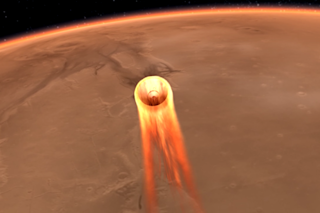From atmospheric entry to landing, InSight will take about seven minutes to reach its final destination. (Credit: NASA/JPL-Caltech) NASA’s InSight lander has been on its way to Mars since May. Now, after six months and 301 million miles (485 million kilometers), InSight is set to touch down on the Red Planet’s surface at 2:54 P.M. Eastern Time this afternoon. The entire process, from atmospheric entry to landing, will take only about seven minutes.
InSight’s landing plan combines technology and techniques from past missions, aiming to successfully transport the 1,340-pound (608 kilograms) probe the 80 miles (128 km) from the top of Mars’ atmosphere to the surface. During the probe’s Entry, Descent, and Landing phase, it will enter the martian atmosphere at a speed of about 12,300 miles per hour (5.5 kilometers per second), with its heat shield reaching up to 2,700 degrees Fahrenheit (1,500 degrees Celsius) as the lander stays ...














